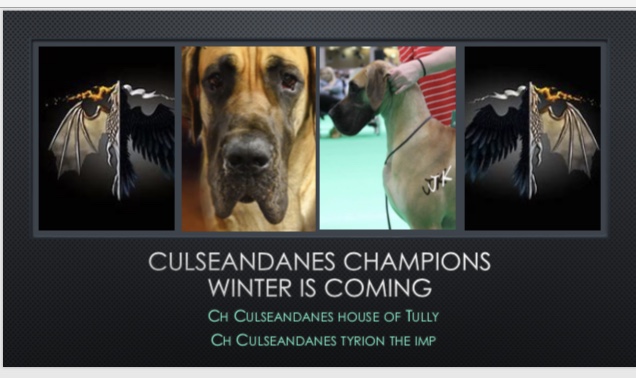11 Aug 2009
Orgins of Our Great Danes
Shrouded in myth the real origin is obscure but historians will tell that man has since early times kept giant smooth coated hounds. There are paintings, tapestries, statues and coins that depict these facts. As these civilisations traded goods the prize hounds were also amongst the items that travelled along the trade routes. So we have evidence that these hounds were wide spread in the areas we know as Poland, Russia, Germany, England and France. The Romans, Assyrians, Greeks and Egyptians all played their part in this episode.
It is to middle Europe, particularly Germany, that the development of the modern Great Dane can be attributed. England also played its part in no small way as the Anglo Saxons kept giant hounds, and with the Roman conquest these highly prized hounds were exported to Rome.
In Germany the northern hounds tended to be a heavily built dog. In the south the hounds tended to be built on much finer lines. Many of the big cities had also established their type, some that come to mind are Stuttgart, Ulm, Berlin, Hamburg and Württemberg all producing their own traits and type.
Important steps were made in Germany after the war of 1870, when it was decided there should be a national dog, the Deutsche Dogge. The aim was to produce a giant hound upstanding with strength in head, body and bone. The various traits of the established hounds were mixed and by selective breeding the foundation of the modern Great Dane was produced. The gathering together of the interested breeders formed the first dog shows. This led to a standard to judge by (probably the first was Herr Scheidoberg’s standard).
Records of breeding came along so interested parties would have first hand knowledge of the pedigree of the dogs they were interested in breeding from.
Around 1874 an important breeder, Max Hartenstein, acquired a dog from the Stuttgart area of Germany. He named him Bosco and by 1876 he had purchased a bitch Bella, and from this pair he bred many Fawns, Blacks, Brindles and Harlequins.
Another important pioneer of the breed, Mr E Mebter, formed his kennel in Northern Germany, and between 1880 and 1890 was exhibiting large numbers of Danes.
In the South the influential breeder, Mr B Ulrich, was establishing his influence, perhaps his best years were between 1882-87.
A fourth influence was the breeding in 1886 in the Berlin area of Mr Aichele's kennel of Schwalbennest Danes, which in the main were blues.
In 1888 came the formation of a club devoted to the breed.
At the turn of the century it must be noted that many of the dogs from Wurttemberg were sold and exported to England and France.
 The good, The bad and The ugly an honest view of the lives of the Great Dane and their owners, plus our showing at champ and open shows.
Come say hi if you see a wee ginger woman with one or four Danes
The good, The bad and The ugly an honest view of the lives of the Great Dane and their owners, plus our showing at champ and open shows.
Come say hi if you see a wee ginger woman with one or four Danes
Subscribe to:
Posts (Atom)

